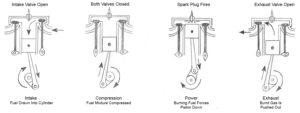Natural Gas-Fired Engine
An internal combustion reciprocating engine used in the natural gas industry at pipeline compressors, storage stations, and gas processing plants. The engine converts energy contained in natural gas into mechanical shaft power, which can be used to drive compressors, pumps, and generators. Internal combustion reciprocating engines require fuel, air, compression, and a combustion source to function. The four-stroke, spark-ignited reciprocating engine has intake, compression, power, and exhaust cycles. In the intake phase, as the piston moves down in its cylinder, the intake valve opens and the upper portion of the cylinder fills with fuel and air. When the piston returns upward in the compression cycle, the spark plug emits a spark to ignite the fuel-air mixture. This controlled reaction, or burn, forces the piston down, thereby turning the crankshaft and producing power. In the exhaust phase, the piston moves back up to its original position and the spent mixture expels through the open exhaust valve.

